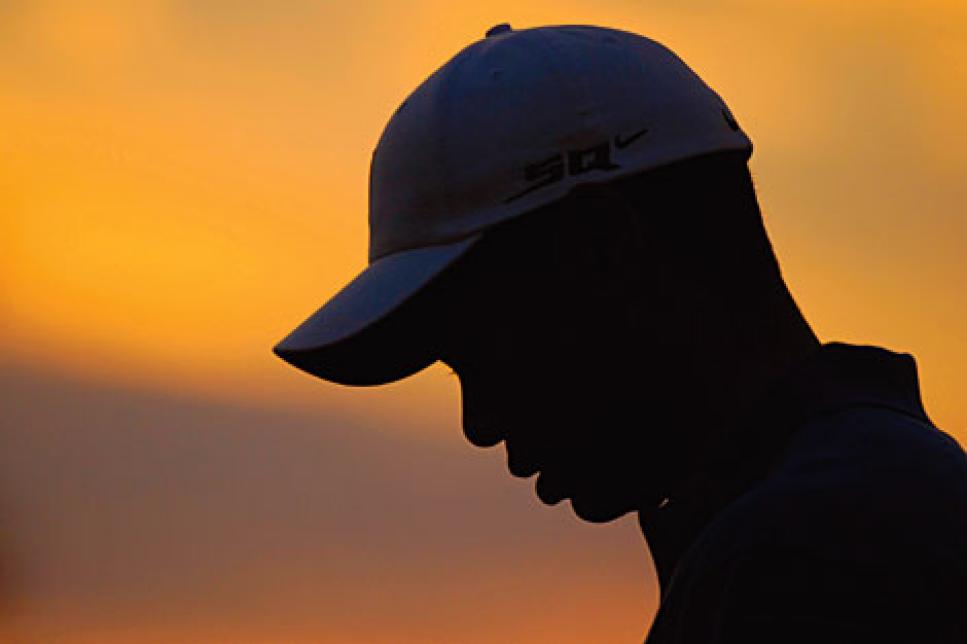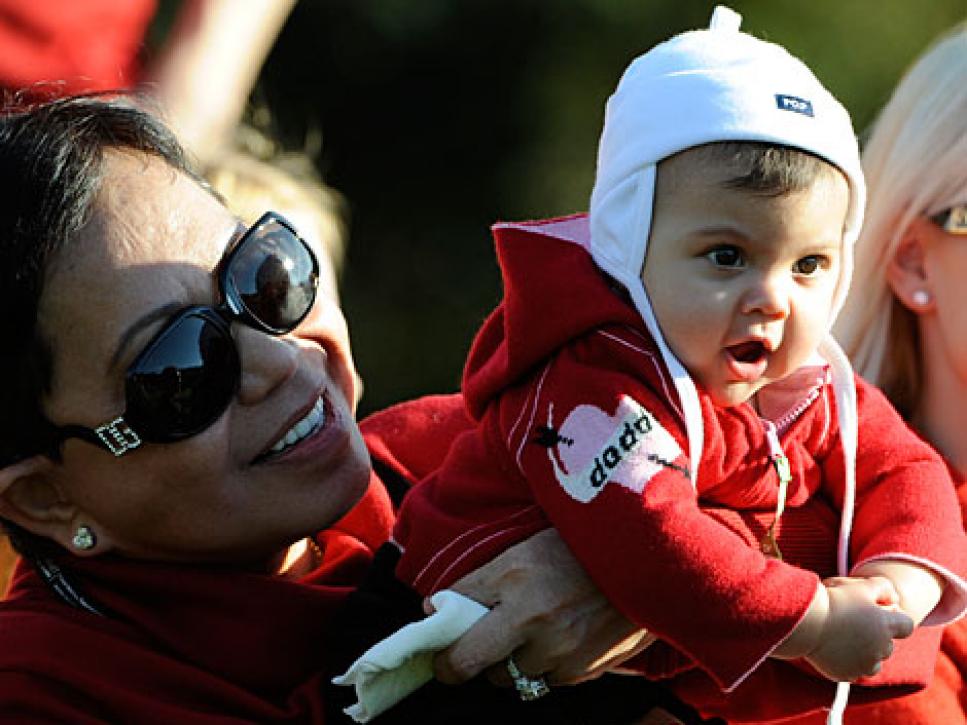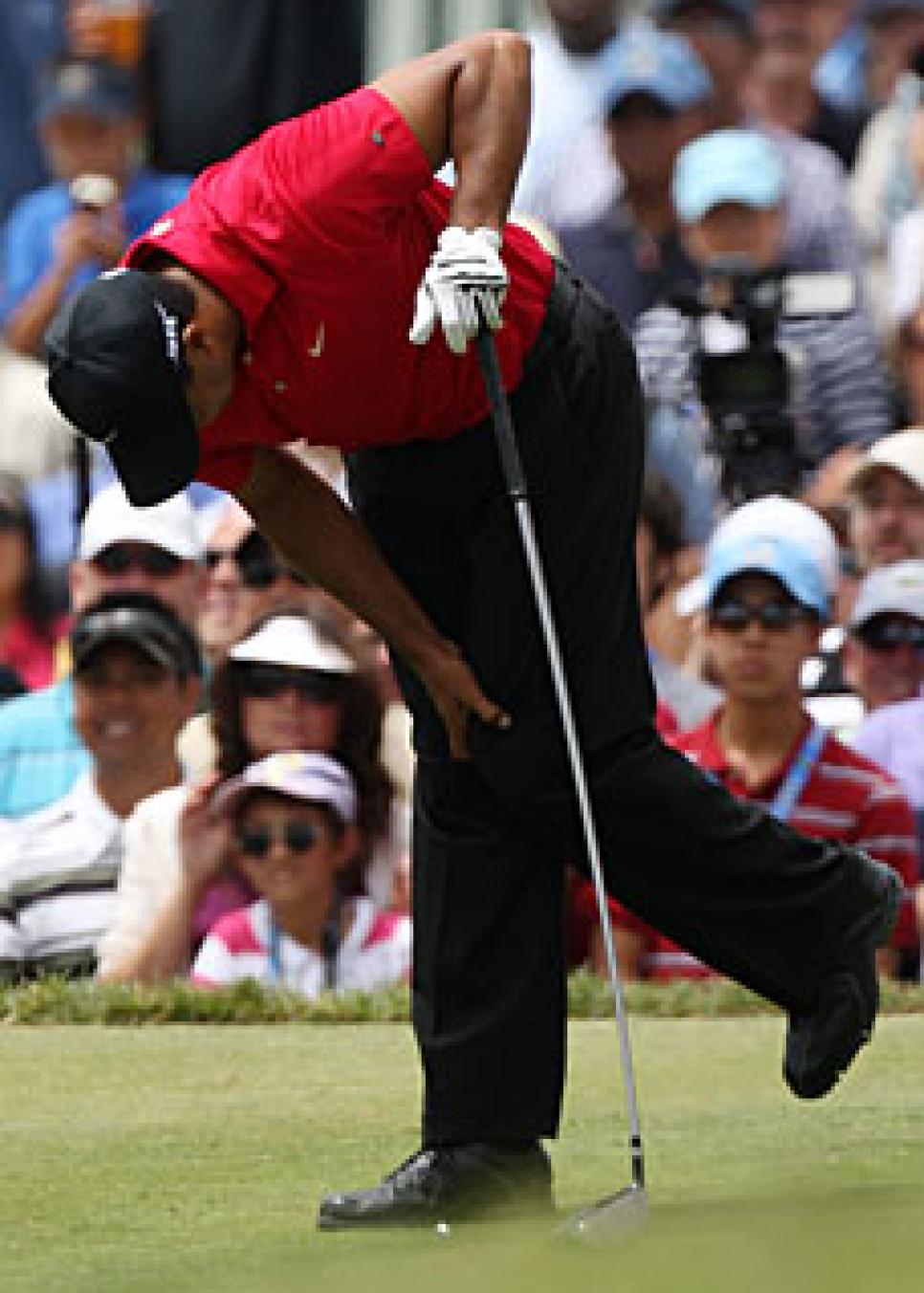News
Away From the Fray

Upstairs, in a board room at Sherwood CC, Tiger Woods is clenching his fists and banging knuckles from one hand across the other, resulting in something of a snap, crackle, pop, like a Rice Krispies breakfast after the milk arrives.
"Before the surgery, if I tried to hold a flex with my left knee, you would hear this," Woods explains. "So I couldn't hold a flex in that leg, and I had to back off my swing. It looked like I was swinging harder, but I was actually swinging slower because I was trying to get off that leg, back up the hips. I never kept my weight on my left side upon impact. I was trying to back up out of it, get off it and somehow time it. Now, I have stability. I have a stable left leg to hit into for the first time in a long time. That's exciting."
Downstairs, in another room, excitement also reigns. Tida, the coolest mother you will ever know, talks about a recent conversation with her famous son. "'Carte blanche,' he told me," she says, utterly beaming. "Whatever is needed, whatever I want. I'm so proud of Tiger." Tida then reaches for pictures from a recent trip to her native Thailand. "See this little girl?" she says. "Two years old, never smiled the whole time I was there. Sad, not normal. I saw 200 children, abandoned or abused, like her. No parents, no home. Some of the older girls, raped by their fathers or sold for prostitution. They need food, shelter, love. They need money. I tell Tiger about it when I come back, that's when he tells me, whatever it takes. He does these things nobody knows about. Not just a golfer, my son. I'm so proud."
As the world's No. 1 player prepares for a return to competition in 2009—ideally, no later than the Masters, perhaps as early as the WGC-Accenture Match Play Championship in late February—Tiger Woods is more balanced than ever as components of his legacy, on and off the course, continue to grow and merge. Rehabilitation from the reconstructive knee surgery following his epic U.S. Open victory in June is going so well that he is hitting full shots now, at first somewhat hesitantly, thinking the pain might return. It doesn't. It's gone.
"My legs are stronger than they've ever been," Woods says while hosting last week's Chevron World Challenge. The notion is seconded by Keith Kleven, Tiger's longtime trainer/fitness guru. "Just a couple days before he went to his tournament, we tested him here in Las Vegas," says Kleven. "He was perfect, the best ever for symmetry, from side to side. And I've been with him since he was at Stanford. Graded out 100 percent. He's ahead of schedule."
Then again, Tiger always is, even when he is at his desk. He turns 33 at December's end; the Chevron event celebrated its 10th anniversary. Think about that. Many athletes learn how to say hello when it's time to say goodbye. Still others postpone giving back until they're retired, until the second half of their lives. Tiger instituted his foundation in 1996 and his learning center in 2006 and now he's got another blank check ready for Tida, who says, "He's done so much so young … he could have waited until he's old, like everybody else."
On this matter, however, Tiger takes issue with Tida, a rarity. "No, no, no, that's not how it works," he says. "I've been very lucky, starting with two great parents. [Father] Earl was a stickler for helping people, and look at Mom now with what's going on in her country. You have to help people along the way. Every day, not just every day after you're done playing golf. We're sending kids to college now who never dreamed of it, whose families never had anyone go to college. I actually wish we could have done some of these things sooner, but we wanted to make sure they were done right. Those are my real trophies. No doubt. They'll outlast me."
The most recent trophy, from Torrey Pines after 91 holes of limping, still amazes Woods. And he is not alone. "I still can't believe he won there," says caddie Steve Williams. "But from the moment the announcement was made about the 2008 U.S. Open at Torrey Pines, Tiger talked about it. For however long that was, maybe five years? He never looked forward to a tournament the way he looked forward to San Diego, even the 2001 Masters, when he went to Augusta trying for four [majors] in a row. I knew the whole nine yards that it was going to be over after that for the year, whatever happened. But there was no doubt about him playing. I didn't bother asking, because I knew the answer."

Kleven chuckles when the subject is broached. "My opinion was not sought out, either," he says. "All week there, Tiger kept telling me, 'I broke it, you fix it.' We went into the wee hours every morning trying to work on the swelling. We stayed with anti-inflammatories and away from harder medicine. You take Vicodin, you lose feeling. Tiger didn't want that. The concern was, beyond the cracks and the stress fracture, that a piece or pieces of bone would break off. Then we'd have had real problems. Worse than what occurred. That would have made recovery longer, more difficult. Fortunately, what he had left, bone on bone basically, held up."
Woods looks robust, terrific. He's swimming, lifting, stretching. He's dropped a couple of pounds, not in his biceps. The regimen of working out never was anathema to him, but now the program has even more purpose. "I can't keep an eye on him when he's home in Florida," says Kleven, "but it's obvious he's totally dedicated."
‘ went from the bedroom to the bathroom to the couch, then back to the bedroom. That was my day. Every day for three weeks. Difficult.'—Tiger Woods
Woods promises that ignoring doctor's orders—such as, for instance, to sit out Torrey Pines—is no longer an option. Tiger chooses not to reprise his gallant act in securing his 14th major conquest, the agony he overcame to achieve it or the misery that followed. "First couple weeks after the [June 24] surgery were tough," says Woods. "I went from the bedroom to the bathroom to the couch, then back to the bedroom. That was my day. Every day for three weeks. Difficult. The only frustration I have now is that this is a day-to-day process. If I had a date in my mind when I want to play again, it wouldn't matter really because I don't know how this is going to respond. The only schedule I know is my workout schedule, but I'm certainly not ready to play yet, and I don't want to go into a tournament again until I am ready. And when I do, I don't want to be the same as I was. I want to be better, which I think I can be because I'll have two good legs for the first time in a while. Right now, I'm antsy, but more to practice than play because I can't do one without the other. I'm really looking forward to practicing. I didn't hit a practice ball after a round, since last year's British Open. I can now."
Williams theorizes that his boss might be less beatable than ever. Some critics surmise that the newer Woods will mean a different swing. "But if a different swing is a sounder swing, then great," says Williams. "Every swing change he's ever made, he's gotten better."
Woods' instructor Hank Haney concurs. "Tiger hasn't had a stable knee for some time, so I don't see how this could be anything but positive," he says. "He wanted to play the Memorial a couple weeks before the Open, badly. I was with him the week before, and he wasn't hitting more than 40 balls at a time off level ground. He had to stop dead in his tracks to get a bottle of water. I thought there was no way he would play San Diego, but I was there when Dr. [Thomas] Rosenberg showed him the stress fractures on the MRI. And Tiger said, 'I'm gonna play.' The doctor didn't know what to say. We went out to practice. The first time he walked 18 was on Thursday at Torrey Pines. He couldn't practice more than nine holes before that, in a cart, couldn't work out, so he was getting weaker and the knee progressively more unstable. It was a downward spiral, but we all knew we were watching something special.
"I don't think this is Tommy John surgery," says Haney, "or the kind of situation for a football player where you wonder whether Tiger will lose a step. Like Tiger says, this isn't Tom Brady coming back from his injury because Tiger isn't going to get tackled. This should only make Tiger better, and that's all he ever thinks about, anyway. Great champions are great climbers, and I've never heard him talk about catching Snead or Nicklaus. He only talks about getting better. The day before his surgery, he was on the phone. 'What's the plan going to be when I come back?' He was going to be out for six or eight months, and he wanted to know what the plan would be. What does that tell you?"
Woods says he has not been watching much golf, and judging by TV ratings in his absence, he is not alone. (Tida departed the Chevron Friday morning: "Tiger doesn't play, I go home. Ha, ha.") Friends say when Tiger volunteered that he doesn't miss playing, it should not be construed as a lack of enthusiasm. He doesn't miss playing, they caution, because he knows he can't. Yet. But when he can, beware. Until then, Tiger admits the enforced sabbatical has refreshed him to a point and allowed him to spend dawn to dusk with daughter Sam. Wife Elin is due in February, by which time he will be at or near the point of rejoining the fray.

"I won't be around our next child like I was near Sam the last few months," he says. "That will be disappointing because I've watched Sam grow before my eyes. Elin talks to her in Swedish, I talk to her in English, and she's got a third language which I don't quite understand."
To Mark O'Meara this latest chapter in the book of Woods is worth savoring. "Phenomenal what he has done with all he's got going on," says O'Meara. "The charity work, the family, the injury after winning a U.S. Open the way he did. I mean, if you're hurting in golf, you can't pass the ball to a teammate. He played five days on a broken freaking leg! Never mind what that does to your mechanics. What does that say about Tiger's pain threshold?
"He'll be better than ever now," O'Meara predicts, "but I don't know how much longer we'll have him around. Six years, eight max. If he's at 20 majors or 22 when he's nearing age 40, I don't think you'll see him hanging around. He hasn't told me anything, but I'm guessing he'll leave sooner rather than later. Tiger Woods is once in a lifetime, so enjoy the ride, folks."